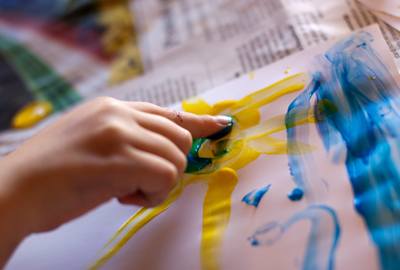
Because manufacturers of art supplies are not required to list ingredients on their products, it's hard for the consumer to know what is toxic and what isn't. The "non-toxic" label can't necessarily be trusted. For example, certain brands of crayons labeled "non-toxic" were found to contain asbestos in 2000 (asbestos was part of the talc used by th e manufacturers as a strengthener). Here are some of the common art supplies used by children and the possible toxins in them.
1. Paint
Powdered tempura paint should not be used, because it can be easily inhaled and can contain toxic pigments such as cadmium and titanium. If you already have powdered tempura paint, mix it with water ahead of time using a dust mask, and let the children use it after it's been mixed. Otherwise, choose children's liquid paints that are water-based. Watercolors are another non-toxic choice. Avoid oil-based paints which can contain toxic solvents.
2. Crayons
As noted above, asbestos was found in talc-containing crayons about a decade ago. However, the manufacturers that were involved no longer use talc in their crayons. Nonetheless, toxicity is a concern with regard to the synthetic pigments and paraffin wax (a petroleum product) used in making crayons. Choose beeswax crayons or crayons made from soy.
3. Clay
Modeling clay made from PVC (polyvinyl chloride) was actually given the stamp of approval by the Art & Creative Materials Institute (ACMI) before its toxic nature was revealed. Avoid plastic-based, synthetic modeling clay that often contains petroleum products and synthetic pigments. Also avoid powdered clays. The best choice is non-colored, air-dry modeling clay or modeling beeswax.
4. Glue
According to the US Environmental Protection Agency (EPA), toxic volatile organic compounds (VOCs) are found in "graphics and craft materials including glues and adhesives." The EPA warns against the effect that VOCs can have on indoor air quality.
Rubber cement and model glue are especially toxic. Instead, choose glues that are low in VOCs, such as cellulose glue, white library paste, Elmer's, or mucilage. Most glue sticks are also low in VOCs. Some art supply companies sell adhesive wax (non-toxic beeswax that is soft and sticky). Or you can make your own paste with white flour and water.
5. Markers
Permanent markers contain toxic solvents like oil-based paints do. Many children (and adults!) complain about the smell of permanent markers, and sometimes that smell can result in headaches and respiratory irritation. Even dry-erase markers emit VOCs. Look for low-odor, water-based markers.
6. Pastels
Because of the powder that is produced when chalk pastels are used, they pose a potential problem of toxicity when inhaled. Once again, toxic pigments such as cadmium and chrome yellow can be inhaled in the dust. Oil pastels contain petroleum products. But like crayons, natural oil pastels (usually soy or beeswax-based) can be used instead.

